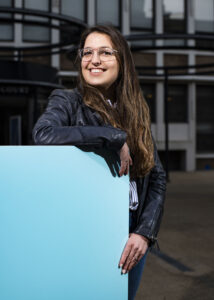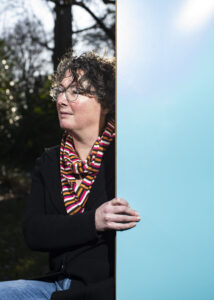CID and the importance of outreach
‘Outreach holds up a mirror to scientists’
Text: Peter de Jonge
Photos: Bram Belloni
Science is indispensable to society, there is no doubt about that. But how do we best convey this knowledge to society, in such a way that these discoveries have a wider reach than just academia. How do we unlock this treasure trove of scientific knowledge for a wide audience? And vice versa, how do we obtain data from society that is relevant to research?
Outreach – coming down from your ivory tower with your research – is the answer, including for the CID. Three CID researchers talk about how outreach features prominently in their work. One plays football at FC Utrecht, another puts up a colour cross at Lowlands or has students chat with the mayor.
 Behavioural scientist Karlijn Hermans (1990) knows her stuff when it comes to outreach. As part of the L-CID, she was not only involved in organising the Expedition Next science festival, but she also initiated the Teacher Project, in which researchers and teachers work together closely.
Behavioural scientist Karlijn Hermans (1990) knows her stuff when it comes to outreach. As part of the L-CID, she was not only involved in organising the Expedition Next science festival, but she also initiated the Teacher Project, in which researchers and teachers work together closely.
‘The CID’s Teachers Project is the ultimate outreach. It is a new approach to research: we share our knowledge of children’s social development with teachers, and we learn from their wealth of experience. They know exactly what works in class.
Another project close to my heart is All Schools Collect (Alle Scholen Verzamelen), in which three thousand children from 76 primary schools took on the role of researchers. Students composed a top five of what they need to be social, such as more breaks or better listening. They then went on to survey adults about what they thought was important. A few children decided to interview none other than their mayor. One of them cleverly reported back to his teacher: ‘We were not able to discuss everything, the mayor is quite a chatterbox.’
‘The most important thing about outreach is that, as scientists, we not only transmit our knowledge but also learn from stories from society.’
Children are very creative in coming up with research questions and they keep you on your toes. For example, a little boy asked his teacher: ‘Why exactly are we participating in this study?’. In this way, children are introduced to how science works in a playful way, and the research connects to children’s social worlds. Citizen science in optima forma.
The most important thing about outreach is that, as scientists, we not only transmit our knowledge but also learn from stories from society. As far as I am concerned, science will become even more open and accessible.’
 Sarah Durston (1974) is professor of developmental brain disorders at UMC Utrecht. In collaboration with the CID, she set up #kletsbaar, a surprising project that has appeared at festivals across the Netherlands.
Sarah Durston (1974) is professor of developmental brain disorders at UMC Utrecht. In collaboration with the CID, she set up #kletsbaar, a surprising project that has appeared at festivals across the Netherlands.
‘My outreach project is called #kletsbaar (a portmanteau of ‘kletsen’, Dutch for chatting and ‘kwetsbaar’, or vulnerable, ed.) – chatting about vulnerability. We want to make people think about psychiatry. Psychiatry should not be abstract and remote, the person is not one with their illness, but someone like you and me, who experiences reality differently due to circumstances. It is something that can happen to all of us. Everyone is vulnerable.
‘Psychiatry should not be abstract and remote, the person is not one with their illness, but someone like you and me, who experiences reality differently due to circumstances.’
Part of my outreach is the Colour Cross (Kleurenkruis), a four-armed, five-coloured inflatable pillow you can climb into. We toured the country with this wobbly 9-by-9-metre cross – we even went to Lowlands. What you notice is that everyone who steps into the cross becomes disoriented. Inside, there are five different colour zones, the sound is distorted, and you cannot see a clear horizon. Reality is momentarily called into question, as it is for someone with a psychiatric disorder. We then discuss psychiatry with the visitors. A total of 3,000 people entered the Colour Cross; 1,800 of them participated in a survey about their views on psychiatry.
I want to use outreach to make psychiatry more human; we need to get rid of the stigma often attached to labels. Take, for example, young people labelled with ADHD. They are told that their brains work differently. This makes them think: ‘Oh, my brain works differently, I’ll never get rid of that.’ But one-third of those with ADHD grow out of it during puberty. I recently heard from a 20-year-old diagnosed with ADHD that he had never learned to concentrate. After all, he was given Ritalin for that. That is what labels do. The CID is about vulnerability, but also about resilience. It is incredibly important that we continue to talk about this.’
 Psychologist Ties Fakkel (1990) is a born storyteller. For instance, he made a vlog for the children in the YOUth study while walking, and recorded a spoken-word performance about unequal opportunities. He studies the influence of parents’ socio-economic status on their children’s development.
Psychologist Ties Fakkel (1990) is a born storyteller. For instance, he made a vlog for the children in the YOUth study while walking, and recorded a spoken-word performance about unequal opportunities. He studies the influence of parents’ socio-economic status on their children’s development.
‘I noticed that only ten per cent of the participants in my research have a lower socio-economic status, while this group constitutes one-third of the Dutch population. Apparently, we are not successful in reaching these people. This is unfortunate, because it is precisely children growing up in more difficult circumstances that are of great value to our research, and vice versa.
Together with colleagues, I set out to find this target group. We contacted schools, libraries, and community centres in working-class neighbourhoods. We also visited FC Utrecht, a real club of the people. The children who play there come from neighbourhoods all around Utrecht and are ethnically much more diverse than those in our study. We taught them playfully how active your brain is during football, for example with dribbling and free running.
‘As researchers, we should go into neighbourhoods much more and make real contact with people. When you visit people’s homes, only then do you really know what is on their minds.’
It has not yet brought in many new recruits, but we have learned plenty. As researchers, we should go into neighbourhoods much more and make real contact with people. So, no academic language or a complicated brochure, but a lot of listening to what matters to the people there. When you visit people’s homes, only then do you really know what is on their minds. Outreach is not just about connecting. It is also a mirror that shows the extent to which we scientists are connected to society.’
As a researcher, Ties not only successfully establishes contact with the outside world, but also within the CID he managed to unite the forces of all research groups for a scientific paper on the under-representation of young people with low socio-economic status. Ties: ‘This project has contributed to the discussion around diversity and inclusivity across CID and beyond.’
Karlijn Hermans was a postdoc with the L-CID in Leiden. Sarah Durston is professor at UMC Utrecht. Ties Fakkel is a PhD student at Utrecht University.
This article is part of a New Scientist special issue about the Consortium on Individual Development, that will appear in September 2023.
